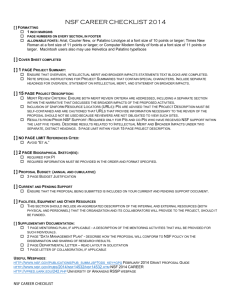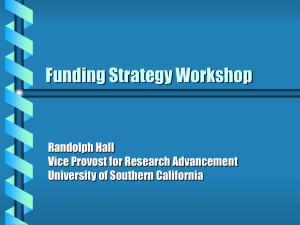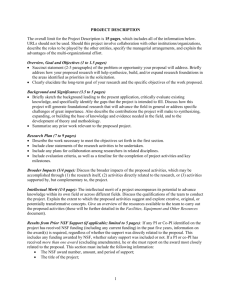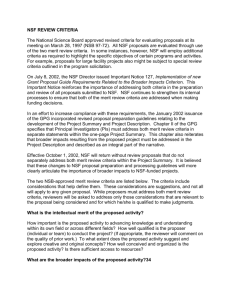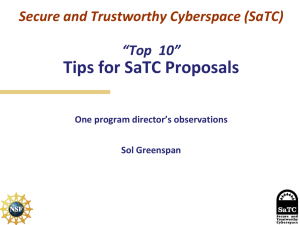Trustworthy Computing Program A CISE Cross
advertisement
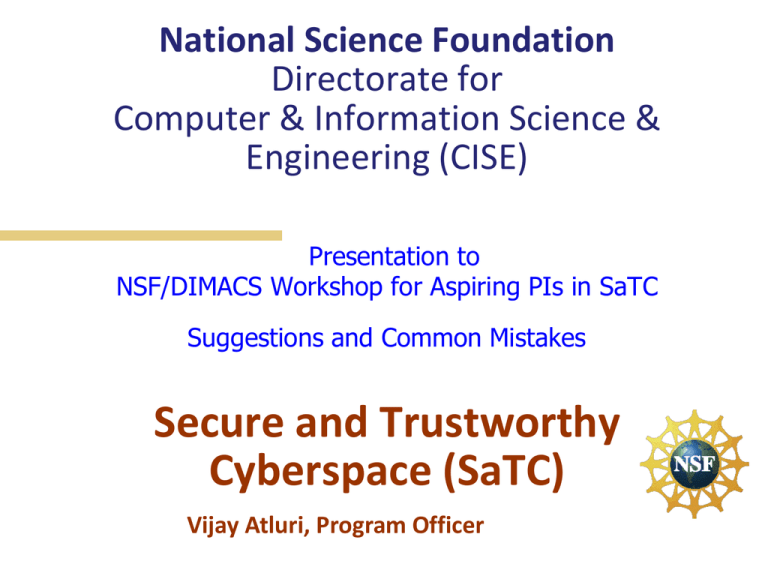
National Science Foundation Directorate for Computer & Information Science & Engineering (CISE) Presentation to NSF/DIMACS Workshop for Aspiring PIs in SaTC Suggestions and Common Mistakes Secure and Trustworthy Cyberspace (SaTC) Vijay Atluri, Program Officer Secure and Trustworthy Cyberspace Program (SaTC) Total budget about $55M (FY12 actual), 2 $75M (FY13 President’s request to Congress) CISE Divisions and Core Programs 3 Proposal Reviewing and Processing Proposal Writing Strategies I • Determine your long-term research and education goals • Develop your bright idea - Survey the literature Contact other investigators currently working on the same subject Prepare a brief concept paper Discuss with your colleagues and mentors Proposal Writing Strategies II • Prepare to carry out your project - Determine available resources Realistically assess your needs Develop preliminary results Present to your colleagues, mentors, and students • Determine possible funding sources • Understand the ground rules - Read solicitations carefully Proposal Writing Strategies III • Proposals are not papers! • Write clearly: Make it very clear what you are proposing • Follow the Model • What is your idea? • Why is it important? • Tricky balance between what you know and what you want to find out • Convince that you are qualified to do the research • project could build on your research strengths • yet you should propose to solve new research problems • Try to anticipate reviewer questions NSF Merit Review Criteria • What is the intellectual merit of the proposed activity? • What are the broader impacts of the proposed activity? Review Criteria: Intellectual Merit • How important is the proposed activity to advancing knowledge and understanding? • How well qualified is the proposer to conduct the project? • Quality of the prior work • NSF does not fund “Trust Me” type proposals – PI qualifications cannot make up for proposal weaknesses • To what extent does the proposed activity suggest and explore creative and original concepts? • How well conceived and organized is the proposed activity? • Is there sufficient access to resources? • NSF encourages high-risk, high-reward proposals Review Criteria: Broader Impact There are many kinds of broader impact: • Promoting teaching, training, and learning. • Broadening participation by underrepresented groups. • Enhancing infrastructure for research and education. • Dissemination of results. • Benefits to society. Proposals are not expected to address all the above aspects Other aspects • Integration of Research and Education: • level of engagement in joint efforts that infuse education with the excitement of discovery and enrich research through the diversity of learning perspectives. 11 Successful Proposals: Top 5 Strengths 1. Important, Timely Topics & Responsive to Needs 2. Expertise in the area, solid prior work 3. Sufficient Detail and Clear Plans 4. Innovative, Novel, with Potential for Big Impact 5. Broader Impact: don’t just write about it but actually think about it and do it! Key Questions • What do you intend to do? • Why is the work important? • What has already been done? • How are you going to do the work? • Who will do what? (If more than one PI) • How do you measure the success? • What is the plan of execution? • Does it fit into the solicitation? Common Mistakes • Not targeted to the right program • No clear separation of what has been done and what is being proposed • No clear “threat model” • • Goals and abilities of the “attacker” No plan for evaluation • To measure the success of the project Targeting to the right program • Example: secure networking proposal – If primarily advance networking -> NeTS – If primarily advance security/privacy -> SaTC • NSF program officers share/transfer proposals between programs to ensure best merit review, but advisable to carefully choose target program 16 Successful PI’s: Top 5 Tips 1. Before you start: read solicitation carefully, talk to PD, understand process at your SRO 2. Project Summary: should be bullet proof, get feedback from everyone including non-experts 3. Literature survey: should be very thorough, careful comparison to related work 4. Proof read it: spell check, grammar, clear and understandable 5. If Rejected: Don’t be discouraged, read reviews carefully, talk to PD to understand what happened, serve on panels, and TRY AGAIN! Limit of 3 proposals per PI per year, 18 2 from Small/Med/Frontier; 1 from EDU SaTC Contacts Jeremy Epstein jepstein@nsf.gov Sam Weber sweber@nsf.gov Ralph Wachter rwachter@nsf.gov Sol Greenspan sgreensp@nsf.gov Nina Amla namla@nsf.gov Vijay Atluri vatluri@nsf.gov Social, Behavioral & Economic Sciences Peter Muhlberger pmuhlber@nsf.gov Cyber Infrastructure Kevin Thompson kthompso@nsf.gov Andrew Pollington adpollin@nsf.gov Education and Human Resources Victor Piotrowski vpiotrow@nsf.gov Engineering Zhi (Gerry) Tian ztian@nsf.gov Networks and Systems Computer & Information Science and Engineering Theory and Foundations Information and Intelligent Systems Mathematical Sciences To sign up for the SaTC email list, send an email to listserv@listserv.nsf.gov with the text of the message being: subscribe SaTC-Announce <your name> For example: subscribe SaTC-Announce Jane Doe 19



